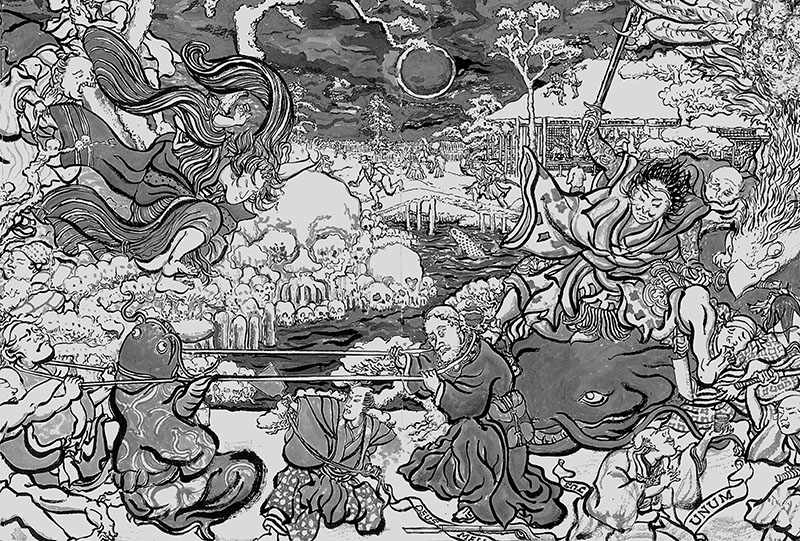|
This show exhibits works in multiple mediums (including photography, ink on paper, and installation) all relevant to 3.11.
It has been almost five years since the disaster, but the Fukushima nuclear plant has yet to cause any severe health issues on the level of Chernobyl as once anticipated by the mass media. If the Fukushima nuclear power plants had indeed suffered a meltdown, why was there no mass-casualty recorded in the official reports? As such, there were many inscrutable mysteries from the early stages of the accident. I had doubts about the so-called 'official' report of 3.11 to begin with, as well as the accounts of events that followed. This led me to actually conduct fieldwork research in the coastal area of Tohoku, participate in demonstrations in front of the National Diet Building, and study sources of theNamazu-e (or 'pictures of the gigantic catfish'). I was fed up of reading news that only shed light on isolated facts and snippets of stories, dismayed by the small number of attempts at capturing any overarching narratives of the disaster. I felt it was up to the individual to connect the dots and to clear up these doubts. So I gathered information, followed the trail of facts, and attempted to unravel 3.11 to my capabilities. The result was the Heisei Catfish Scrolls, the second and third volumes of which are exhibited as the central works of this show, the entire tripartite series measuring 20 metres long in total.
Following the Ansei earthquake near Edo in 1855, many artists created woodblock prints in colour of the historical disaster, now collectively referred to as the Namazu-e, of which more than 250 examples still exist to this day. They were based on the Japanese folklore that explained how earthquakes were caused by giant catfish, normally sealed underneath a stone set by the Kashima daimyojin. Studying these works, I noticed that the catfish were depicted in three ways: one as an antagonist acting as a catharsis for the people to express their anger; two as an enemy-turned-ally of the people after being beaten by the Kashima daimyojin; and three as the godly figure of Yonaoshi daimyojin, the god of world rectification. Drawing parallels between these changing roles of the catfish to the Tohoku earthquake and tsunami, the nuclear accident, and the Ise pilgrimage, I have attempted to interpret the series of incidents after 3.11 to come full circle. TheNamazu-e is not just a reportage of one natural disaster, but a drama that captures the varied and complex interpretation of how such events affect human society. By weaving elements from the Namazu-e and other works from the era seamlessly into the flow of events that followed the explosion of the Fukushima nuclear plant, I have attempted to interpret the post 3.11 situation in continuation with history that has recurring relevancy to the people of today.
These scrolls are a result of drawing together a variety of elements including Japanese mythology, folklore, ethics, religion, customs, and current domestic politics with the occasional spot of humour. I hope this exhibit provides viewers with an opportunity to reconsider the events of 3.11 in contemplating the future to come.
http://www.gallery.arttrace.org/201602-takada.html
Information Provided by: Art Trace Gallery
Period: February 19,2016 (Fri) 〜 March 15,2016 (Tue)
Hours: 12:00~19:00
Closed: Wed
Venue: Unfolding 3.11
|


